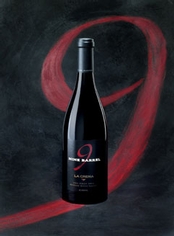Cool climate is a term that is bandied about frequently in wine circles. But what does it mean? That depends on who you’re asking. In general, though, cool growing regions are considered ideal for early-ripening varieties like Pinot Noir and Chardonnay, during the growing season of April to October in the Northern Hemisphere. Vineyards in these regions have lower average mean temperatures throughout the growing season, often accompanied by morning fog.
In California, the coastal strip stretching from Mendocino County in the north to Santa Barbara County in the south may be the largest cool climate grape-growing area in the world. The winemaking team at La Crema, in Sonoma County, works with the cool climate concept every day, producing Chardonnay and Pinot Noir, from grapes grown in California’s premier vineyard regions that hug the Pacific coast in Northern California.
La Crema winemaker Melissa Stackhouse and her staff source  Chardonnay and Pinot Noir from the Russian River Valley, Sonoma Coast, Anderson Valley, Los Carneros, Arroyo Seco and the broader appellation of Monterey, all considered cool climate growing areas. Russian River Valley alone is the source for grapes from six vineyards, with Laughlin and Piner Vineyards to the north and south of the winery in Windsor, Sonoma County. Even with all these sources, Stackhouse is always looking for new and different expressions of Pinot Noir. “We bottled a 2008 Bennett Valley Pinot Noir earlier this year. It has good high-tone flavors and acidity. And we have an Arroyo Seco (Monterey) Pinot that looks very promising.”
Chardonnay and Pinot Noir from the Russian River Valley, Sonoma Coast, Anderson Valley, Los Carneros, Arroyo Seco and the broader appellation of Monterey, all considered cool climate growing areas. Russian River Valley alone is the source for grapes from six vineyards, with Laughlin and Piner Vineyards to the north and south of the winery in Windsor, Sonoma County. Even with all these sources, Stackhouse is always looking for new and different expressions of Pinot Noir. “We bottled a 2008 Bennett Valley Pinot Noir earlier this year. It has good high-tone flavors and acidity. And we have an Arroyo Seco (Monterey) Pinot that looks very promising.”
What does Stackhouse think of the claim that Pinot Noir is a difficult grape to grow and wine to make? “Pinot Noir is a thin-skinned grape that is very vulnerable to heat, so in an extreme vintage where there’s high heat, you have to be careful,” she says. On the other hand, Cabernet Sauvignon has its own problems in the vineyard, but it doesn’t succumb to heat the way that Pinot Noir does.” As for difficulties with making Pinot Noir, Stackhouse says, “my best advice is to taste a lot and don’t move the wine a lot.”
Besides the Bennett Valley and Arroyo Seco Pinots, Stackhouse is holding two Appellation Series Los Carneros wines for release later this year. La Crema 2008 Los Carneros Chardonnay, $30 has moderate oak and alcohol, good structure and inviting lemon-mineral notes. The 2008 Los Carneros Pinot Noir, $38 is well-structured with bright berry and spice flavors, good length and a pleasing freshness across the palate. Also tasted was the La Crema 2008 Russian River Valley Pinot Noir, $38, with slightly muted aromatics but big expressive complex flavors; and an exciting 2008 Russian River Valley Chardonnay, $30, showing lovely mineral and ripe pear flavors, excellent balance and good length. Stackhouse said that La Crema will not bottle the 2008 Anderson Valley Pinot Noir because of smoke taint resulting from wildfires that year.
At the top of La Crema’s line is a pair of limited-production wines called  “Nine Barrel.” Stackhouse notes that the wines that carry the Nine Barrel designation are bottled from nine barrels that are the best that she and her winemaking team taste from the vintage year. “We lay out the wines for the Russian River blend then select the best nine barrels.” La Crema 2007 Russian River Valley Nine Barrel Chardonnay, $70 is rich and decadent with ripe fruit and creamy texture; for those who like Chardonnay with big flavors and oak. La Crema 2007 Russian River Valley Nine Barrel Pinot Noir, $90 is rich and supple with lots of toasted oak and good pinot flavors.
“Nine Barrel.” Stackhouse notes that the wines that carry the Nine Barrel designation are bottled from nine barrels that are the best that she and her winemaking team taste from the vintage year. “We lay out the wines for the Russian River blend then select the best nine barrels.” La Crema 2007 Russian River Valley Nine Barrel Chardonnay, $70 is rich and decadent with ripe fruit and creamy texture; for those who like Chardonnay with big flavors and oak. La Crema 2007 Russian River Valley Nine Barrel Pinot Noir, $90 is rich and supple with lots of toasted oak and good pinot flavors.
La Crema Chardonnay and Pinot are noteworthy examples of California cool climate wines. A few regions outside California that qualify as cool climate include Champagne, Burgundy, Germany, New Zealand and the Adelaide Hills or South Australia, Tasmania and certain parts of Victoria. Hobart, the capital of Tasmania will host the 2012 International Cool Climate Symposium. The centerpiece of the symposium that draws wine people from around the world will be the results of three-year research project into Pinot Noir and sparkling wines.
6
